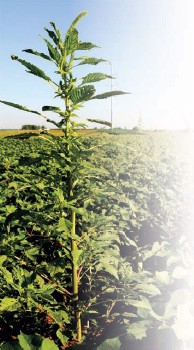Invasion of the Superweeds

By Samba Lampich
On 12 million U.S. acres, farmers are battling the rise of superweeds — mutant crop destroyers that are a real threat to agriculture. These weeds have developed a resistance to the most commonly used herbicides. Superweeds reduce crop quantity by competing for moisture, light and nutrients; they also harbor insects and diseases that destroy crops.
About 15 percent of U.S. corn, soybean and cotton crops are now infested with superweeds. They are more likely to grow near or with genetically engineered (GE) crops that were created (ironically) to withstand large applications of herbicides and pesticides. GE crops were first planted in the 1970s and grew in popularity due to their ability to increase crop yields and reduce farming costs (fewer herbicides required). Today, they account for an average of 90 percent of the superweedplagued crops in the United States.
Over the years, these weeds mutated and became herbicide-resistant, passing the mutation from generation to generation. In a retrospectively illconceived response, farmers began using more and multiple herbicides to save their crops, which only fueled the growth of superweeds. The weeds spread from farm to farm by air or water, and/or were carried by insects and animals; soon superweeds were cropping up across the country. Today, there are at least 20 weed species in the U.S. that no longer respond to herbicides.
The rise and rapid spread of superweeds has triggered discussions about the use of GE crops, herbicide alternatives and unconventional weed-control practices. Some companies are working on engineering new GE crop varieties with stacked herbicide resistance traits that can tolerate multiple herbicides. There is concern that these new crops will only create more herbicideresistant weeds — super superweeds. Other scientists and farming reformers want farmers to practice preventive strategies that rely less on chemicals and more on traditional farming techniques. These include crop rotation using certified seeds, cutting and destroying crops infested by weeds, and maintaining a clean farm to prevent weed seeds from spreading. The discussions have also focused on how and where food is grown, the use of chemicals and their impact on the environment, and the prevention of a new ecological problem — insects resistant to pesticides or superbugs.
Classroom Discussion
- How do pesticides and herbicides help/hurt?
- What are some advantages and disadvantages of genetically engineered (GE) foods?

